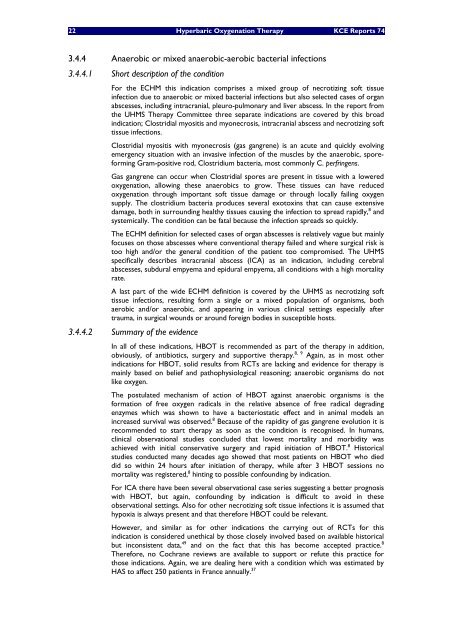Download the full report (130 p.)
Download the full report (130 p.)
Download the full report (130 p.)
You also want an ePaper? Increase the reach of your titles
YUMPU automatically turns print PDFs into web optimized ePapers that Google loves.
22 Hyperbaric Oxygenation Therapy KCE Reports 74<br />
3.4.4 Anaerobic or mixed anaerobic-aerobic bacterial infections<br />
3.4.4.1 Short description of <strong>the</strong> condition<br />
For <strong>the</strong> ECHM this indication comprises a mixed group of necrotizing soft tissue<br />
infection due to anaerobic or mixed bacterial infections but also selected cases of organ<br />
abscesses, including intracranial, pleuro-pulmonary and liver abscess. In <strong>the</strong> <strong>report</strong> from<br />
<strong>the</strong> UHMS Therapy Committee three separate indications are covered by this broad<br />
indication; Clostridial myositis and myonecrosis, intracranial abscess and necrotizing soft<br />
tissue infections.<br />
Clostridial myositis with myonecrosis (gas gangrene) is an acute and quickly evolving<br />
emergency situation with an invasive infection of <strong>the</strong> muscles by <strong>the</strong> anaerobic, sporeforming<br />
Gram-positive rod, Clostridium bacteria, most commonly C. perfringens.<br />
Gas gangrene can occur when Clostridial spores are present in tissue with a lowered<br />
oxygenation, allowing <strong>the</strong>se anaerobics to grow. These tissues can have reduced<br />
oxygenation through important soft tissue damage or through locally failing oxygen<br />
supply. The clostridium bacteria produces several exotoxins that can cause extensive<br />
damage, both in surrounding healthy tissues causing <strong>the</strong> infection to spread rapidly, 8 and<br />
systemically. The condition can be fatal because <strong>the</strong> infection spreads so quickly.<br />
The ECHM definition for selected cases of organ abscesses is relatively vague but mainly<br />
focuses on those abscesses where conventional <strong>the</strong>rapy failed and where surgical risk is<br />
too high and/or <strong>the</strong> general condition of <strong>the</strong> patient too compromised. The UHMS<br />
specifically describes intracranial abscess (ICA) as an indication, including cerebral<br />
abscesses, subdural empyema and epidural empyema, all conditions with a high mortality<br />
rate.<br />
A last part of <strong>the</strong> wide ECHM definition is covered by <strong>the</strong> UHMS as necrotizing soft<br />
tissue infections, resulting form a single or a mixed population of organisms, both<br />
aerobic and/or anaerobic, and appearing in various clinical settings especially after<br />
trauma, in surgical wounds or around foreign bodies in susceptible hosts.<br />
3.4.4.2 Summary of <strong>the</strong> evidence<br />
In all of <strong>the</strong>se indications, HBOT is recommended as part of <strong>the</strong> <strong>the</strong>rapy in addition,<br />
obviously, of antibiotics, surgery and supportive <strong>the</strong>rapy. 8, 9 Again, as in most o<strong>the</strong>r<br />
indications for HBOT, solid results from RCTs are lacking and evidence for <strong>the</strong>rapy is<br />
mainly based on belief and pathophysiological reasoning; anaerobic organisms do not<br />
like oxygen.<br />
The postulated mechanism of action of HBOT against anaerobic organisms is <strong>the</strong><br />
formation of free oxygen radicals in <strong>the</strong> relative absence of free radical degrading<br />
enzymes which was shown to have a bacteriostatic effect and in animal models an<br />
increased survival was observed. 8 Because of <strong>the</strong> rapidity of gas gangrene evolution it is<br />
recommended to start <strong>the</strong>rapy as soon as <strong>the</strong> condition is recognised. In humans,<br />
clinical observational studies concluded that lowest mortality and morbidity was<br />
achieved with initial conservative surgery and rapid initiation of HBOT. 8 Historical<br />
studies conducted many decades ago showed that most patients on HBOT who died<br />
did so within 24 hours after initiation of <strong>the</strong>rapy, while after 3 HBOT sessions no<br />
mortality was registered, 8 hinting to possible confounding by indication.<br />
For ICA <strong>the</strong>re have been several observational case series suggesting a better prognosis<br />
with HBOT, but again, confounding by indication is difficult to avoid in <strong>the</strong>se<br />
observational settings. Also for o<strong>the</strong>r necrotizing soft tissue infections it is assumed that<br />
hypoxia is always present and that <strong>the</strong>refore HBOT could be relevant.<br />
However, and similar as for o<strong>the</strong>r indications <strong>the</strong> carrying out of RCTs for this<br />
indication is considered unethical by those closely involved based on available historical<br />
but inconsistent data, 49 and on <strong>the</strong> fact that this has become accepted practice. 8<br />
Therefore, no Cochrane reviews are available to support or refute this practice for<br />
those indications. Again, we are dealing here with a condition which was estimated by<br />
HAS to affect 250 patients in France annually. 37

















